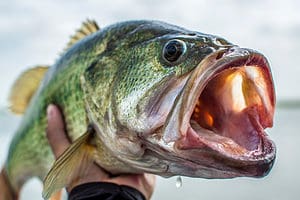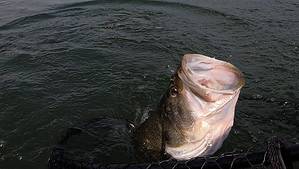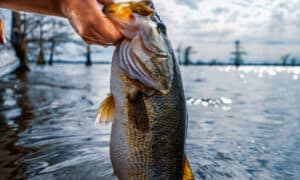The largemouth bass (Micropterus salmoides) is North America’s most popular freshwater sport fish. Anglers of all stripes target these fish, from recreational anglers fishing in neighborhood ponds to professional anglers fishing from $100,000+ bass boats equipped with cutting-edge technology. But just how big can these bass grow? The potential size of largemouth bass depends on a number of factors.

Largemouth bass sizes can vary widely based on environmental and genetic factors.
©Maclane Parker/Shutterstock.com
A Sunfish, Not a Bass
The largemouth bass is not a true bass. Rather, it is a member of the sunfish family (Centrarchidae). Smallmouth and rock bass are also sunfish, along with common panfish species such as crappie and bluegill. The temperate bass (also known as true bass) family (Moronidae) includes species such as striped bass and white bass, among others.
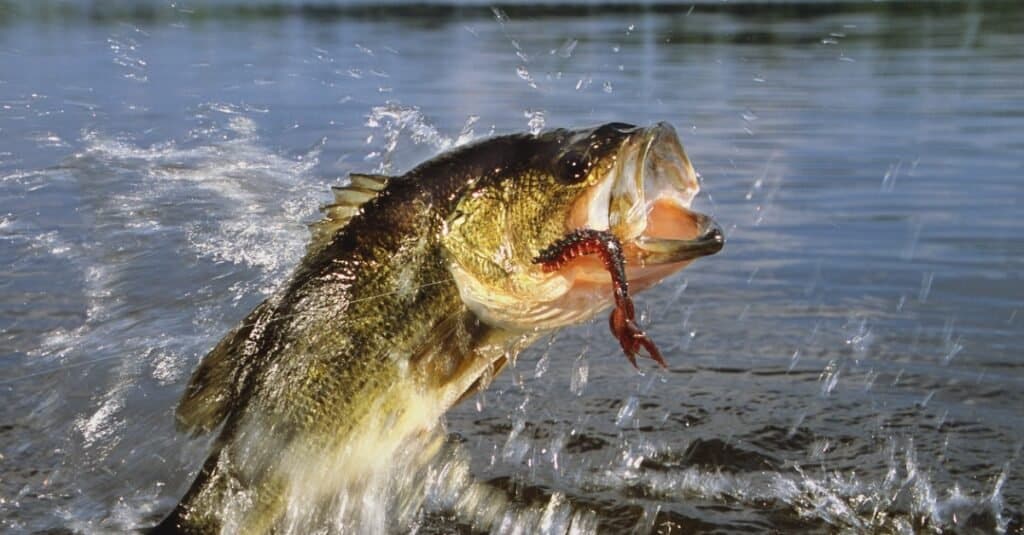
An average largemouth bass will weigh from one to five pounds.
©iStock.com/stammphoto
The largemouth bass is the biggest member of the Centrarchidae family. An average largemouth will measure 11-20 inches long and weigh from one to five pounds. Under the right conditions, though, these aggressive predatory fish can grow quite a bit bigger than that.
The Largest Largemouth Bass Ever Caught
The biggest largemouth ever caught weighed over 22 pounds. The world record is an anomaly because two largemouth bass currently occupy first place. The tie is between two fish that were caught 77 years apart.
The record-setting largemouth bass was caught on June 2, 1932. George Perry landed that monster bass while fishing in Montgomery Lake, an oxbow of the Ocmulgee River in southern Georgia. Perry’s largemouth bass record would stand for over three-quarters of a century.
Here is a rare picture of Perry and his record-setting fish provided by Bass Fishing Facts.
On July 2, 2009, Manabu Kurita was fishing on Lake Biwa, northeast of Kyoto, Japan. That is where he hooked into a massive largemouth that would land him in the record book, as well. Outdoors 360 provided this picture of Kurita and his lunker largemouth.
Perry’s fish weighed 22 pounds, 4 ounces. Kurita’s bass was 22 pounds, 4.97 ounces, beating Perry’s bass by almost one ounce. However, the two fish are officially tied for the world record.
The International Game Fish Association (IGFA) documents fishing world records. The organization requires a new record fish to weigh at least two ounces more than the old record. Kurita’s fish was less than one ounce heavier than Perry’s bass, so they are officially tied for the world record at 22 pounds, 4 ounces.
Contributing Factors for Largemouth Bass Sizes
While it is highly unlikely that a bass angler will catch the next world record on his/her next fishing trip, big largemouth bass abound in the United States. It usually takes time for these fish to grow to trophy sizes, though. A Florida study of 822 trophy bass (ten pounds or larger) revealed the bass had a mean age of 9.7 years. That is roughly one pound of growth per year.
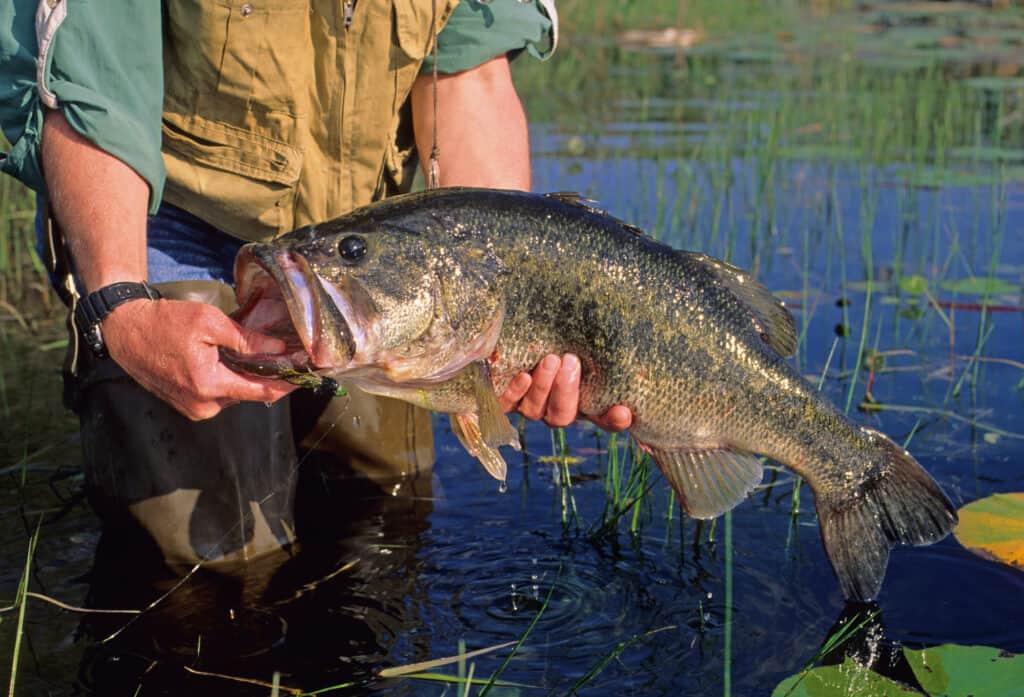
A ten-pound largemouth, such as this one, is usually nearly ten-years-old, but there are exceptions.
©iStock.com/stammphoto
Largemouth bass never stop growing. The growth rate typically slows down as the fish ages, but it never stops. Though it is rare, largemouth bass can live 18+ years in the wild. The oldest wild largemouth bass on record was 23 years old. That bass was caught in 1992 in New York. It weighed 6.8 pounds, which is nice largemouth, to be sure. However, it was far from what you might expect a fish that old to weigh.
Like most things in nature, the growth of largemouth bass is not a straight line that moves up and to the right. It depends on a variety of environmental and genetic factors.
Climate
For instance, largemouth bass in warmer climates typically grow larger than those in more northerly regions. When the weather turns cold, bass enter a torpor state. They still feed during the winter. Anglers can even catch largemouths while ice fishing. However, the fish’s feeding rate drops significantly from the warmer months. On the other hand, bass in warmer climates do not enter torpor during the winter. They feed regularly year-round, which allows them to grow larger.

Castaic Lake in California is one of the best lakes in the nation for trophy largemouths.
©iStock.com/David Diaz
An examination of all the different world record categories for largemouth bass reveals an obvious pattern. There are currently 36 different classes and categories for record largemouths. Other than one fly fishing record set in Pennsylvania, every record was set in a warm climate. California, Florida, Texas, and Mexico are all on the list. The two biggest largemouths in history were caught in warm weather regions of Georgia and Japan.
Static vs. Flowing Water
A close look at all of IGFA’s largemouth bass records reveals another pattern: almost all the record fish were caught in lakes.
One reason the largemouth bass is the most popular freshwater sport fish in North America is its proliferation. These fish can be found in ponds, estuaries, streams, and rivers. But they grow to their largest sizes in lakes.
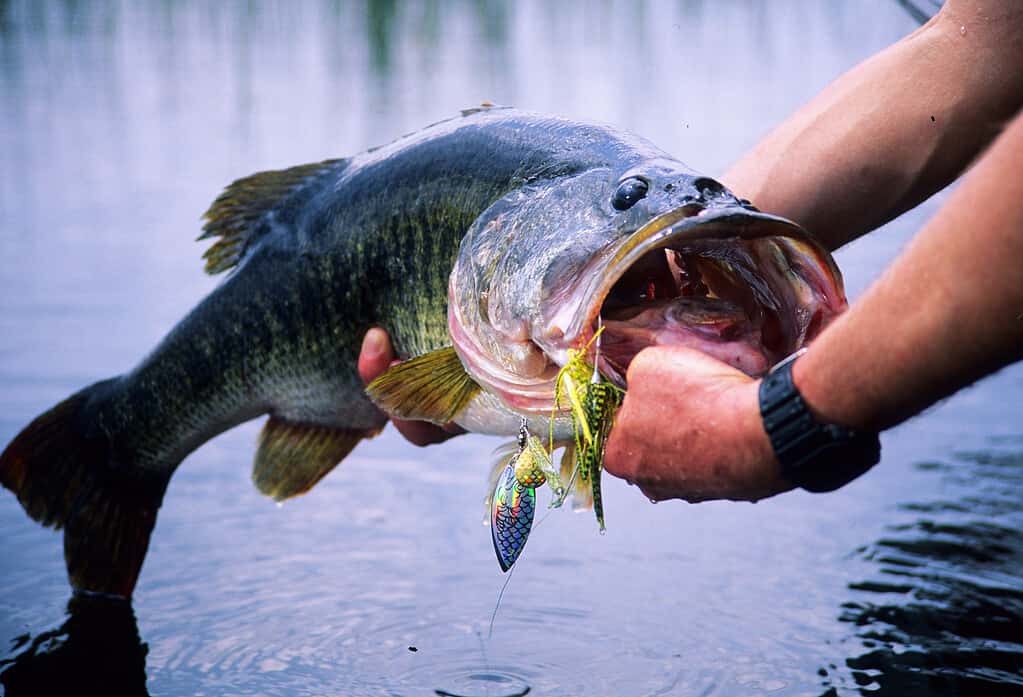
Trophy largemouths, such as this 12-pounder, are typically caught in lakes.
©iStock.com/stammphoto
Quality largemouth bass can certainly be caught in rivers, but they are usually smaller than lake bass. Exceptionally large bass are usually found in lakes that are big enough to support the food web needed for the bass to grow. The static water of a lake also allows the fish to grow larger. River bass are constantly expending energy to navigate the current. Lake bass do not have to burn calories to fight the current because the water is static. This allows them to pack on the pounds, similar to how humans gain weight if they eat a lot while expending little energy.
Subspecies
There are two subspecies of largemouth bass: Florida largemouth bass (Micropterus s. floridanus) and northern largemouth bass (Micropterus s. salmoides). This is another important factor in determining the size of the fish.
The two subspecies often mirror each other in size and weight, with the Florida bass being the slightly larger of the two. But what is often unseen is the difference in growth potential between the two. While they are often about the same size, the Florida largemouth has the genetic potential to grow to gargantuan size in the right conditions. The northern largemouth is not genetically capable of the same growth. That’s not to say that anglers can’t catch a big (even a trophy) northern largemouth. They certainly can. But northerns don’t reach the absurd sizes that Floridas sometimes do.

The Florida largemouth bass has greater growth potential than northern largemouths.
©Daniel Estabrooks / CC0 – License
Best Places and Time of Year to Catch Largemouth Bass
If you have aspirations of catching a record bass, a lake in a warm-weather location is your best bet. However, as stated earlier, largemouth bass can be found in all types of environments. Everything from a farm pond to a river to a lake can host large numbers of bass. Even if they aren’t always record-setters, largemouth bass are hard-fighting fish that are found throughout the U.S.
Spring is often viewed as the best time for bass fishing. In northern states, the fish emerge from winter dormancy and shift into a period of furious feeding. Spawning beds also provide great sight-fishing targets in clear water environments.
Summer can be a great season for bass fishing, but the best fishing is typically early or late in the day. When the sun is high in the sky during the middle of summer, bass often press the pause button on feeding as they retreat to deeper, cooler water. An hour or so before dusk and the first couple of hours after sunrise can be the best bass fishing times during the summer.

Morning is often the best time to fish during the summer.
©Pierre Rebollar/Shutterstock.com
Fall is a favorite for bass anglers. The weather is cooler, making it more comfortable to go fishing. And the bass, especially in colder regions, often feed furiously as they prepare for the upcoming lean winter.
The photo featured at the top of this post is © iStock.com/stammphoto
Thank you for reading! Have some feedback for us? Contact the AZ Animals editorial team.



